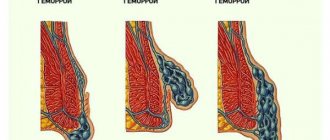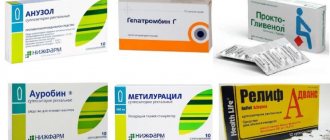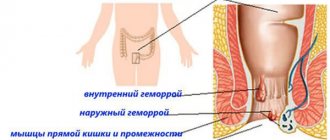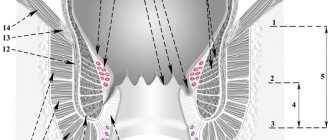Therapy during pregnancy is calculated according to an individual scheme and may include a variety of drugs with an analgesic, anti-inflammatory, and laxative spectrum of action. The treatment algorithm takes into account the timing, complexity of the disease and associated complications. Complex procedures can be postponed to a later date - after the birth of the baby and in the absence of breastfeeding.
Hemorrhoids during pregnancy - causes
Hemorrhoids are dilated veins at the end of the anus. It happens that due to various factors, blood vessels dilate. Hemorrhoids are most often caused by irregular bowel movements. Pressure on the stool causes the rectal veins to fill with blood under high pressure and thus develop into painful and bleeding hemorrhoids.
Unfortunately, constipation is very common in the second half of pregnancy. They are mainly caused by high concentrations of progesterone in the blood (which relaxes smooth muscles) and pressure from the expanding uterus on the intestines and veins in the abdomen. However, not every pregnant woman is forced to do this. As always, a lot depends on genetic factors and proper prevention.
At the Bionics Rehabilitation Medicine Clinic, you can undergo a histological examination and receive qualified treatment.
What medications for hemorrhoids can pregnant women take?
In the treatment of hemorrhoids, two types of drug treatment can be used: local and systemic. During pregnant women, local treatment is preferred to systemic treatment.
Local treatment. Today, there are a large number of different medications for the local treatment of hemorrhoids, which are available in the form of suppositories or ointments and creams. Local application of drugs reduces the risk of side effects, increases the effectiveness of treatment and reduces the negative impact of treatment on the fetus. The action of these drugs is aimed at rapid pain relief, limiting inflammation and swelling, normalizing blood circulation in the rectum, counteracting vascular thrombosis, relaxing the rectal sphincter, reducing intestinal motility (motor activity) and softening stool.
Rectal suppositories for hemorrhoids are inserted into the rectum after bowel movements. The suppository should be inserted while lying on your side, without pushing it into the ampulla of the rectum, but holding it in the anal canal for 1-2 minutes: this way it will dissolve and its insertion will be more comfortable.
Hemorrhoids during pregnancy - symptoms
The most common symptoms of hemorrhoids:
- blood in stool;
- residues of stool on underwear between bowel movements (despite compliance with the rules of intimate hygiene);
- burning and itching in the anal area.
Symptoms that may indicate hemorrhoids should prompt the expectant mother to visit a doctor. There are many other causes of anal itching and bleeding from the end of the gastrointestinal tract. Such symptoms cannot be underestimated, so it is necessary to visit a family doctor who will examine the patient and, if necessary, refer the patient for further diagnostics.
Ointments with vasoconstrictor and venotonic properties
Ointments for external hemorrhoids for pregnant women are prescribed to improve blood circulation in cavernous formations. Venotonic drugs are designed to restore the elasticity of the walls of blood vessels and improve venous blood flow.
Also used are agents with a vasoconstrictor effect, which are intended to stop bleeding and relieve swelling of hemorrhoids.
Troxevasin
The drug, classified as a venotonic and angioprotector, increases the tone of the venous walls, increases their elasticity and reduces fragility, relieves inflammation and swelling.
In addition, Troxevasin reduces the severity of pain and prevents the formation of blood clots in the venous ducts. At the initial stages, the gel is able to completely restore blood circulation in the veins.
The drug not only relieves hemorrhoids during pregnancy, but also effectively fights conditions such as:
- venous insufficiency;
- varicose veins;
- spasms of the rectal valve.
Troxevasin reduces the severity of pain and prevents the formation of blood clots in the venous ducts.
Contraindications. The gel is prohibited for use if you are intolerant of the active or additional ingredients. Also, the product should not be applied to deep wounds and infectious processes in the anorectal area.
Application. Venotonic can be used at any stage of gestation with the permission of the treating doctor. The drug is applied to the damaged area or a compress soaked in the product is applied to the external hemorrhoids.
Price. The drug can be purchased without a prescription for 180-210 rubles.
Troxerutin
The drug acts similarly to Troxevasin, since it contains the same active ingredients. This venotonic helps normalize blood circulation, prevent the formation of blood clots, eliminate congestion in the anal veins and relieve inflammation and swelling.
Among the indications of the medicine are:
- external hemorrhoids;
- swelling of the anorectal area after hemorrhoidectomy;
- venous insufficiency.
Contraindications. The list of contraindications coincides with the restrictions that the previous venotonic agent has.
Troxerutin helps normalize blood circulation and prevent the formation of blood clots.
Application. But on this point there are some discrepancies. Troxerutin is prohibited in the first 12 weeks of gestation; its use can only be started from the third trimester. Apply the gel to the damaged external nodules in the morning and evening.
Price. The expectant mother may be pleasantly surprised by the price of the medicine. In pharmacy chains it costs approximately 35-40 rubles for a 40-gram tube.
Relief
The product contains a unique ingredient - shark liver oil, which helps stop bleeding, accelerate tissue regeneration, relieve inflammation and itching.
The second active component, phenylephrine, is a pronounced vasoconstrictor that prevents bleeding and relieves swelling of tissues.
In addition to external hemorrhoids, the drug is used to treat:
- internal hemorrhoids;
- rectal fissures;
- itching in the anus.
Contraindications. The ointment is prohibited for use in cases of intolerance to the constituent elements of the product, blockage of blood vessels with blood clots, or a blood disease in which the number of granulocytes is reduced. Due to the vasoconstrictor effect, the drug is prescribed with caution to hypertensive patients.
Relief is approved for use during pregnancy, but only under strict indications.
Application. The product is approved for use during pregnancy, but only under strict indications. Apply the ointment twice a day to the affected areas or inject it into the rectum using an applicator.
Price. The medicine can be purchased for 390 rubles per tube.
How to avoid hemorrhoids during pregnancy?
As you know, prevention is always better than cure. In the case of hemorrhoids, this rule is of great importance, because this is a rather painful problem that is difficult to get rid of. So what can you do to avoid this “burning” disease?
- Drink a lot! Drink plenty of unsweetened liquids frequently and regularly. During pregnancy, it is best to drink more than 2 liters of fluid per day! The liquid relaxes the stool, making defecation easier. However, mineral water and herbal teas to drink during pregnancy are the best choices.
- Eat healthy foods regularly. Instead of 3 large servings, choose smaller ones, but eat every 2-3 hours. Avoid heavy fatty foods. Also try to limit sweets. You will see that not only will you get rid of constipation, but you will also feel better! Eat foods high in fiber. Fiber is an ingredient that will definitely help you if you have problems with regular bowel movements. Fiber is not digested, but passes through the entire digestive system and clears it of debris. Where can you find fiber? Mostly in dark bread, wholemeal pasta or brown rice. Grain bran and cereals are also an excellent source of fiber. Fiber can also be found in many vegetables and fruits, such as beans, broccoli, carrots and Brussels sprouts. Dried fruits, especially plums, are very rich in fiber. It is worth soaking them overnight in water, and in the morning eating the plums and drinking the resulting liquid.
- Move a lot! Physical activity during pregnancy is highly recommended! Regular exercise helps with proper digestion and improves your well-being! When you're pregnant, there really are so many different sports to choose from! Walking or swimming is not only safe, but also highly recommended for mothers.
Basic principles of treatment of hemorrhoids in pregnant and postpartum women
G
Emorrhoids are one of the most common human diseases. The main reasons for this are the vertical position of the body, diet, sedentary work and adynamia. It is generally accepted that hemorrhoids occur significantly less often in women than in men. However, studies have shown that hemorrhoids are quite common among women, but most of them do not attach any importance to it and do not consult a doctor.
The manifestation or exacerbation of hemorrhoids in women occurs mainly during pregnancy and childbirth, which is associated with blood stagnation due to increased intra-abdominal pressure. Constipation, which often occurs in pregnant women due to a hypotonic state of the rectum, can also be a provoking factor. Constipation is observed in 53% of pregnant women, including in 86% of cases with hemorrhoids. As your pregnancy progresses, the likelihood of developing hemorrhoids increases. However, in women with a family predisposition to venous pathology, as a rule, hemorrhoids appear already in the first – early second trimester, because stagnation of blood in the veins of the pelvis and lower half of the body aggravates both the pathology of the cavernous tissue of the rectum and the veins of normal structure. The question of the primary or secondary development of hemorrhoids in pregnant women has not been fully studied and is presented in the literature by diametrically opposed points of view, which does not reduce its relevance for practitioners who are daily faced with the problem of its treatment. It has also been noted that hemorrhoids occur more often during the first and second pregnancies than during subsequent ones.
Hemorrhoids manifest themselves in the form of two main syndromes - an acute attack and a chronic course of the disease.
The basis for the development of acute hemorrhoids is most often thrombosis of hemorrhoids. Thrombosis of hemorrhoids is characterized by their enlargement and compaction and is accompanied by pain in the anus. Thrombosis usually begins in the internal nodes and subsequently spreads to the external ones. This process is usually accompanied by severe pain in the anus. Less common is isolated thrombosis of external nodes, manifested as a dense, rounded formation.
A typical symptom complex of the chronic course of the disease consists of repeated bleeding, most often associated with defecation and prolapse of hemorrhoids from the anus. Quite often, all these signs are combined with anal itching or a feeling of burning, weeping, and rawness in the anus.
External hemorrhoids are distinguished
, formed from the lower venous plexus and located directly under the skin of the anus, as well as
internal hemorrhoids
, formed from the upper venous plexus and located in the submucosal layer of the rectum.
Bleeding, as the leading symptom of hemorrhoids, is observed in more than half of patients. The second most common symptom of hemorrhoids is prolapse of hemorrhoids. This disease also causes symptoms such as anal itching (9%), discomfort in the anal canal (5%), and mucus discharge (2%).
All of the above, naturally, does not contribute to the normal course of pregnancy. Therefore, if hemorrhoids exist, but do not cause particular concern, it is necessary to prevent complications. First of all, it is necessary to regulate the frequency of bowel movements. This procedure should occur at the same time every day. With the help of a diet, they try to avoid constipation and perform gymnastic exercises. The diet should be rich in vegetables and fruits with a moderate amount of meat and carbohydrates, dairy products and black bread are healthy. Hygiene of the anus area is very important. You need to wash yourself with cold water after each bowel movement. External hemorrhoids do not require surgical treatment. Internally, in most cases, you can limit yourself to drug therapy.
Currently, medications have appeared on the Russian pharmaceutical market that can be used with great effect in the treatment of this pathology.
The purpose of this study
was an assessment of the effectiveness and tolerability of Gepatrombin G (ointment and rectal suppositories) in the treatment of hemorrhoids in pregnant and postpartum women.
Clinically, the symptom complex of hemorrhoids during pregnancy
was almost no different from that among other categories of patients with this diagnosis. Of 232 pregnant women with clinical signs of hemorrhoids, pain in the anus was observed in 46.1%, rectal bleeding in 37.1%, and anal itching in 27.6%. Often, the observed women had external hemorrhoids (61.3%), characterized by the appearance of hemorrhoids in the form of warty formations or folds, dense to the touch and not decreasing in volume upon palpation. In internal hemorrhoids (38.7%), the nodes were located between the folds of the mucous membrane, could be either single or multiple, collapsed when pressed and filled when coughing. In 11.5% of cases, hemorrhoids were combined with an anal fissure. Often, pregnant women, after a 2-3-day delay in stool, suddenly developed painful, dense hemorrhoids, which was accompanied by acute pain and, less often, bleeding. It should be noted that if in pregnant women aged 20 to 30 years, hemorrhoids were detected in approximately every fifth, then after 30 years - in every second.
From our point of view, for practice it is advisable to distinguish three groups of pregnant women suffering from hemorrhoids
. We included asymptomatic hemorrhoids in the first group. These women underwent preventive measures, including a diet with limited spicy foods and a sufficient amount of plant fiber, physical therapy, walks, anal water toilet after defecation, and laxative herbs. Timely identification of pregnant women with clinically asymptomatic hemorrhoids and implementation of such preventive measures in them makes it possible to prevent the development of the disease, which complicates the course of childbirth and the postpartum period.
The second group consisted of patients with complaints of bleeding, anal itching, and pain during defecation. These women, in addition to the above measures, were treated with suppositories and Gepatrombin G ointment from the second trimester.
The third group included pregnant women suffering from hemorrhoids subject to surgical treatment. These were three women with large prolapse of internal nodes and with a history of frequent exacerbations, patients with profuse debilitating hemorrhoidal bleeding, as well as with acute hemorrhoids in the stage of necrosis of the prolapsed strangulated nodes. Pregnant women were consulted by a proctologist, with whom further management tactics were developed. These patients were also prescribed Hepatrombin G for preoperative preparation according to individual regimens.
Gepatrombin G
is a combination drug that contains 3 active components - heparin, prednisolone, polidocanol. Heparin is a direct anticoagulant that activates antithrombin III, neutralizing a number of factors (XIIa, XIa, Xa, XIIIa), and disrupts the transition of prothrombin to thrombin. When applied topically, heparin prevents the formation of blood clots, has an anti-edematous and anti-inflammatory effect, and promotes the regeneration of connective tissue. Prednisolone is a synthetic glucocorticoid that has anti-inflammatory and antiallergic effects, reduces itching and burning sensation. Polidocanol is a compound of the polyethylene glycol group that has a local sclerosing and analgesic effect. Thus, the pharmacological effect of this combination drug for the treatment of hemorrhoids is associated with local anesthetic, anti-inflammatory, antithrombotic, antispasmodic and antipruritic effects.
Gepatrombin G ointment was used for external hemorrhoids, applied to the affected areas in a thin layer 2–4 times a day, and after the pain disappeared, once a day for 7 days. Gepatrombin G suppositories were used for internal hemorrhoids 2 times a day for 5–7 days, after the disappearance of painful sensations, once a day for another 7 days.
The severity of remaining clinical symptoms was assessed by patients as moderate by day 7 of treatment and weak by day 15.
Clinical tolerability was assessed by patients and doctors on a scale: excellent, good, average, poor. Tolerability of treatment with Gepatrombin G was excellent and good in 95% of cases.
Pregnancy, although not the main pathogenetic factor of hemorrhoids, often reveals it and aggravates its clinical course. On the other hand, hemorrhoids in pregnant women often complicate the course of childbirth and the postpartum period. During labor, when the head passes through a narrow part of the pelvic cavity, compression occurs on the vessels of this area, including the rectum. Disrupted venous outflow and blood stagnation create additional conditions for the opening of arteriovenous anastomoses directly into the lumen of the cavernous cavities of the rectum. During pushing, as is known, the anal sphincter opens, the distal end of the rectum gapes, and at the same time both external and internal hemorrhoids are clearly visible. When the fetal head erupts, the internal nodes, if they are sufficiently pronounced, are squeezed out and sometimes their walls are torn. After childbirth, with a gradual contraction of the anus, the internal nodes contract and correct themselves. If the sphincter contracts quickly, these nodes are pinched and acute hemorrhoids occur.
In our study, Gepatrombin G ointment was used in postpartum women
(87 people) with hemorrhoids of I–II severity (4 times a day for the first 2–3 days, then 1–2 times a day until discharge). In some patients, despite a noticeable reduction in nodes in the first days of treatment, pain persisted during defecation, which served as the basis for prescribing cleansing enemas with preliminary introduction of 30–40 g of petroleum jelly into the anus. By the time of discharge, all observed postpartum women considered themselves healthy and were discharged in satisfactory condition.
Thus, the study allows us to conclude that the use of the drug Gepatrombin G, both in the form of an ointment and in the form of rectal suppositories, is an effective way to treat pregnant and postpartum women with hemorrhoidal crises.
The speed of action and good tolerability of the drug allows us to recommend it for widespread use in obstetric and gynecological practice. Literature:
1. Rivkin V.L., Kapuller L.L. Haemorrhoids. M., Medicine, 1984, 176 p.
2. Shekhtman M.M. Haemorrhoids. // 9 months, 2001; 10:11.
3. Contou J. Complications des hemorroides. // Rev. med., 1997; 22 (20): 1199–205.
4. Muller–Lobeck H. Hemorrhoids: trends in treatment. // Chirurg, 2001; 72 (6): 667–76.
5. Wasvary HJ, Hain J, Mosed–Vogel M et al. Hemorrhoids // Dis. Colon Rectum, 2001; 44(8):1069–73.
Hemorrhoids during pregnancy - how to treat?
If no home remedies to avoid painful hemorrhoids have failed, you can resort to pharmacological remedies or the help of specialized doctors. Hemorrhoids are such a serious problem that it should not be postponed. It is best to ask your doctor or pharmacist which medication for hemorrhoids during pregnancy is safe.
Applying cold compresses (such as ice, wrapped in a towel) to the sore areas can provide immediate relief. However, remember that you cannot do so-called sit-ins. They can contribute to vasodilation and, as a result, worsening hemorrhoids.










